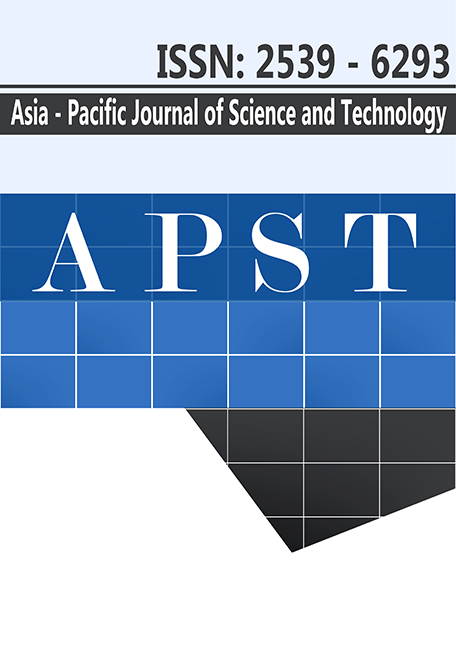A framework of learning achievement by steam education for system analysis and design in case study RMUTT
Main Article Content
Abstract
The purpose of the study were: 1) to develop framework by STEAM (Science, Technology, Engineering, Arts and Mathematics) education for system analysis and design, 2) to study the students’ satisfaction for STEAM education teaching integrated for system analysis and design, and 3) to study students’ behaviors after promotion of learning. The sample of this research was the computer science undergraduate students in the first semester of the academic year 2016 at Rajamangala University of Technology Thanyaburi. The number of samples 90 people, research tools that include: 1) lesson plans and activities plan, 2) the achievement test for pre-test and post-test in each hour, 3) the observation record of students’ behaviors in classroom, and 4) the evaluation from of learning and teaching at the end of course. The results show that the post-test score was significantly higher than that the pre-test, which verified the validity and reliability by statistics of Kolmogorov-Smirnov Z test and Wilcoxon Signed Ranks Test. For learning behaviors, all of them showed their responsibility to class regularly and did other jobs during the class. Two students per class (2.22%) missed the class and three students per class (3.33%) attended the class later than 5 minutes. In summary, A Framework of Learning by STEAM education for System Analysis and Design is enhancing learning potential with the intention could help students to improve their learning achievement and behavior in the class and can be used as a tool for learning enhancement.
Article Details
References
[2] Aronin, S., Floyd, K. K., 2013. Using and iPad in inclusive preschool classrooms to introduce STEM concepts. Teaching Exceptional Children, 45, 34 – 39.
[3] Breiner, J. M., Carla, C. J., Harkness, S. S., Koehler, C.M., 2012. What is STEM? A discussion about conceptions of STEM in education and Shelly Sheats Harkness Partnerships. School Science and Mathematics, 112, 3-11.
[4] Casner-Lotto, J., Barrington, L., 2006. Are they really ready to work? Washington, DC: Conference Board, Partnership for 21st Century Skills, Corporate Voices for Working Families, and Society for H.R. Management. 8
[5] Darling-Hammond, L., 2006. Powerful learning – What we know about teaching for learning. New York: Jossey-Bass.
[6] Dejarnette., 2012. America’s children: providing early exposure to STEM (science, technology, engineering and math) initiatives. Education, 133, 77 – 84.
[7] Fraenkel, J.R., Wallen, N. E., Hyun, H.H., 2012. How to Design and Evaluate Research in Education, 8th edition, New York: McGraw Hill.
[8] Hattie, J. A. C., Timperley, H., 2007. The Power of feedback. Review of Educational Research, 77, 81-112.
[9] Illeris, Knud., 2004. The three dimensions of learning. Malabar, Fla: Krieger Pub. Co. ISBN 9781575242583.
[10] Inan, F. A., Lowther, D. L., Ross, S. M., Straht, D., 2010. Pattern of classroom activities during students’ use of computers: Relations between instructional strategies and computer applications. Teaching and Teacher Education, 26, 50-546
[11] Kemmis, S., McTaggart, R., 1982. The Action Research Planner, Deakin University Press, Voctoria, Australia.
[12] Ledward, B. C., Hirata, D., 2011. An overview of 21st century skills. Summary of 21st Century Skills for Students and Teacher, by Pacific Policy Research Center. Honolulu: Kamehameha Schools-Research & Evaluation.
[13] McFarlane, A. E. (Ed.), 2003. Assessment for the digital age. Assessment in Education, 10(3), 261 - 66.
[14] Ministry of Science and Technology, 2012. President Obama Announces New Plan to Create STEM Master Teaching Corps. [WWW Document] URL https://obamawhitehouse.archives.gov /blog/2012/07/18/president-obama-announces-newplan-create-stem-master-teaching-corps, (accessed 17. 06. 17.).
[15] Ormrod, Jeanne., 2012. Human learning (6th Ed.). Boston: Pearson. ISBN 9780132595186.
[16] Partnership for 21st Century Skills, 2009. Professional development for the 21st century. [WWW Document] URL https://www.p21.org/documents/P21_Framework.pdf, (accessed June 17. 06. 17.).
[17] Partmership for 21st Century Skills, 2007. Beyond the Three Rs:Voter Attitudes Toward 21st Century Skills. Tucson, AZ:Author.
[18] Rossetti, J., Fox, G.P., 2009. Factors related to successful teaching by outstanding professors: An interpretive study. Journal of Nursing Education, 48, 11-16.
[19] Saifa, Y., 2012. The Achievement with Science, Technology, Arts, and Mathematics by STEAM Model. [WWW Document] URL https://www.education.com/workshop_down-load_handout_download.php?id=60*page=4, (accessed 17. 06. 17.).
[20] Simandan, D., 2013. Introduction: Learning as a geographical process. The Professional Geographer, 65, 363-368.
[21] Siripattachai, P., 2013. STEM Education to develop skill in 21st Century. Journal of Business, 33, 49-56.
[22] Slavin, R. E., Tanner, A. M., 1995. Effects of cooperative reward structures and individual accountability in
roductivity and learning. Journal of Educational Research, 72(5), 294-298.
[23] Steffe, L.P., Gale, J., (Ed.)., 1995. Constructivism in education. UK: Lawrence Erlbaum Associates. Publishers.
[24] Taras, M., 2003. To feedback or not to feedback in student self-assessment. Assessment and Evaluation in Higher Education, 28, 549-565.
[25] Tishman, S., Perkins, D.N., Jay, E.S., 1995. The thinking classroom: learning and teaching in a culture of thinking. Boston: Allyn and Bacon.
[26] Tondeur, J., van Keer, H., van Braak, J., Valcke, M., 2008. ICT integration in the classroom: challenging the potential of a school policy. Computer & Education, 51, 212-223.
[27] Trilling, B., Fadel, C., 2009. 21st Century learning skills. San Francisco, CA: John Wiley & Sons.
[28] Watthananon, J., 2015. A Comparison the Effectiveness of STEM Learning and Imagineering Learning by Undergraduate Student in Computer Science. International Journal of the Computer, the Internet and Management, 23,
5-52.
[29] Wayne, C., 2012. What is S.T.E.M and why do I need to know? Retrieved February 2, 2013, [WWW Document] URL https://issuu.com/carleygroup/docs/stem12-online/1
[30] Wenglinsky, H., 2004. Closing the racial achievement gap: The role of reforming instructional practices. Education Policy Analysis Archives, 12, 1-24.


